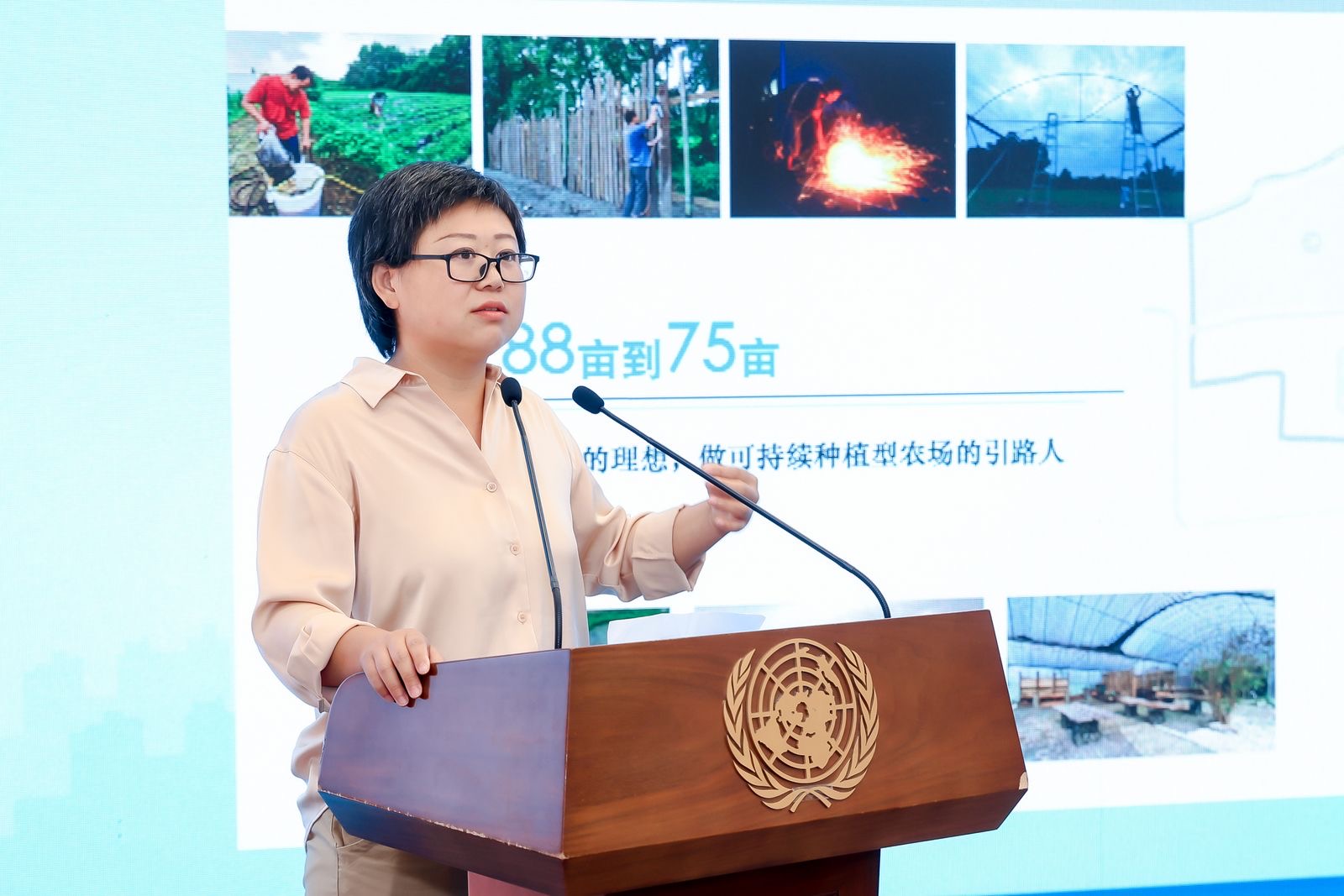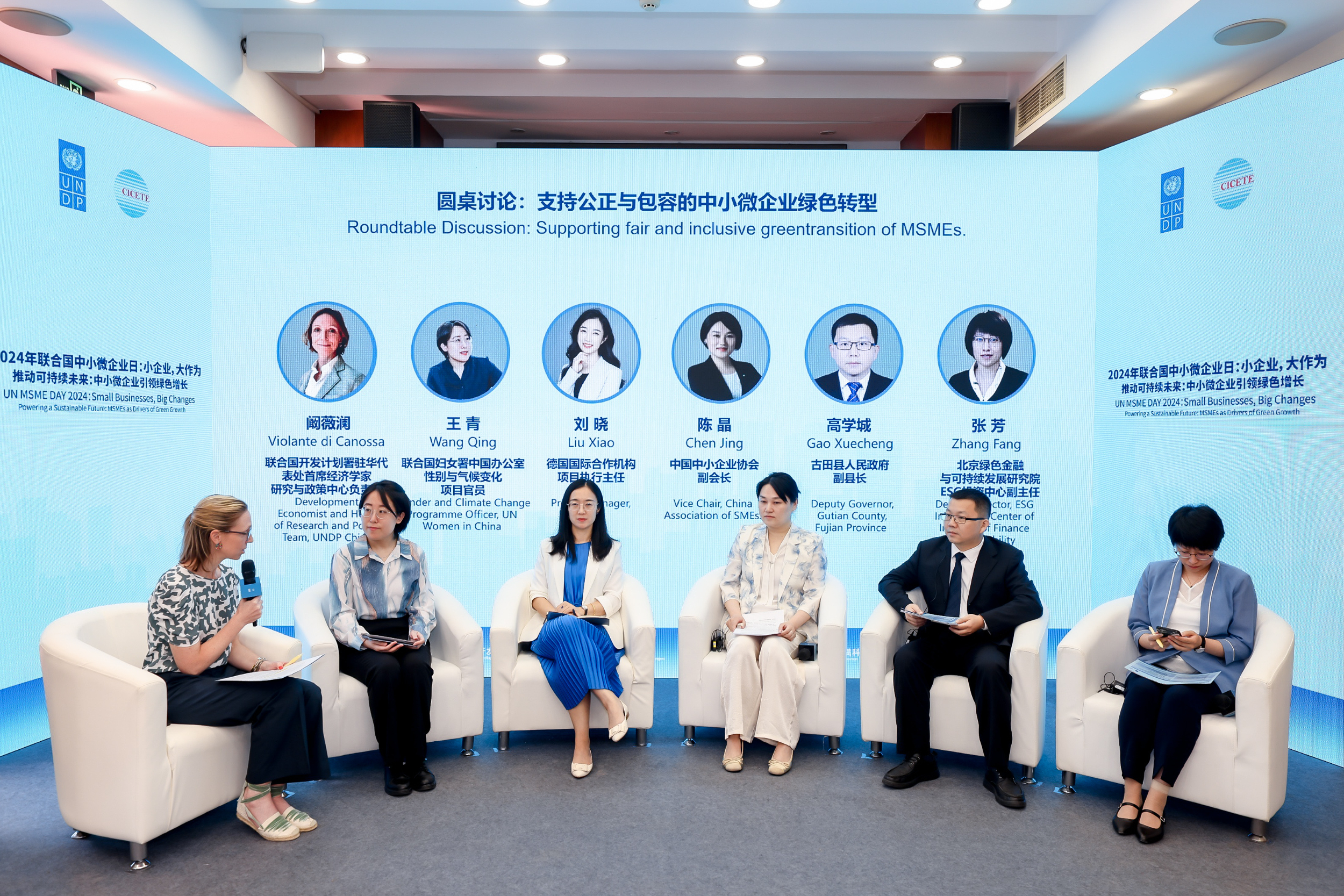To help achieve the "double carbon" goal, how can small, medium and micro enterprises ride the wind and waves?
"Our small businesses are the light, but we have a lot of energy gathered in our bodies. We want to be seen, and we need to be supported." Recently, at the Beijing venue of the 2024 United Nations Small, Medium and Micro Enterprises Day themed event, Sun Wanying, founder of Gulu Ecological Farm, said affectionately. As a representative of small, medium and micro enterprises, she shared her gains and growth in exploring and building a moderate-scale ecological farm.

Sun Wanying is sharing. Map provided by the activity party
In fact, expanding scale and transforming green is not easy for small, medium and micro enterprises. Weak ability to resist risks, financing difficulties, slow technological updates, and market uncertainty are all difficulties and challenges it faces.
How to empower small, medium and micro enterprises for green transformation? At the venue, representatives of United Nations agencies in China, government departments, industry associations, academic institutions and outstanding small, medium and micro enterprises held discussions.
Green development, small businesses also have big responsibilities
"Small, medium and micro enterprises have strong innovation capabilities and flexibility to adapt to market needs and technological changes, and have certain potential in promoting green development and growth." Zhang Yi, deputy director of the China Center for International Economic and Technological Exchanges, pointed out.
How much can small, medium and micro enterprises contribute to promoting green and low-carbon development and achieving the "double carbon" goal? If this potential is fully tapped, what effect can it achieve?

Roundtable discussion session. Map provided by the activity party
Zhang Fang, deputy director of the ESG Investment Center of the Beijing Institute of Green Finance and Sustainable Development, said that last year, the institute took the commercial circulation industry as an example and conducted a "theory + practice" study and found that when small and micro enterprises deeply participate in industry reduction. At the time of carbon reduction, the carbon reduction of the entire commercial circulation industry will be about 2.4 times that when it participated lightly.
Extending from specific industries to the global scale, small, medium and micro enterprises carry out green practices, which have a profound impact on social groups at multiple levels. Data shows that globally, small, medium and micro enterprises account for 90% of the total number of enterprises, 70% of total employment, and 50% of global GDP, particularly benefiting women, youth and marginalized and vulnerable groups.
"By empowering small, medium and micro enterprises to flourish, we can not only promote the realization of the Sustainable Development Goals, but also build an economic system that is inclusive of all and actively respond to the challenges posed by climate change, thereby ensuring a prosperous, harmonious and sustainable future." Bai Yating, representative of the United Nations Development Program in China, said.
But she also pointed out that climate change, geopolitical conflicts, and climate-related catastrophic weather have all posed increasingly serious challenges to small, medium and micro enterprises, which has affected their ability to create new jobs and drive green technology innovation.
Zhang Xiaohui, chief economist of the Small and Medium-sized Enterprises Development Promotion Center of the Ministry of Industry and Information Technology and the China Association for International Cooperation of Small and Medium-sized Enterprises, also said that since the "double carbon" goal was put forward, the green development process of small and medium-sized enterprises still needs to be accelerated. The "2023 Research Report on Green and Low-Carbon Development Paths of China's Small and Medium-sized Enterprises" shows that the carbon emissions of China's small and medium-sized enterprises currently account for 46% of the country's industrial sector's carbon emissions.
He believes that the main challenges faced by small, medium and micro enterprises in the process of green development are: insufficient understanding of low-carbon transformation, green and sustainable development, difficulty in action due to constraints such as financial and technical conditions, and the external policy environment still needs to be improved.

Zhang Xiaohui is giving a speech. Map provided by the activity party
With the help of many parties, small businesses can make great achievements
How to solve the dilemma of relatively slow green growth for small, medium and micro enterprises and accelerate their green transformation?
Based on the challenges raised by Zhang Xiaohui, Chen Jing, vice president of the China Small and Medium-sized Enterprises Association, further introduced the current relevant measures of government departments and associations to assist the green development of small, medium and micro enterprises.
In order to create conditions for small, medium and micro enterprises to become a driving force for green growth, in recent years, relevant government departments have successively introduced a series of measures, involving subsidies for green factories, research and development of low-carbon energy-saving technologies, and support for project investment and technological transformation funds. At the same time, the China Association of Small and Medium-sized Enterprises also holds trade fairs every year to help small and medium-sized enterprises build a platform for connecting industry and finance and provide them with financial support. It also organizes relevant forums with scientific research institutions, social organizations and relevant government departments to unite leading enterprises and scientific research at home and abroad. The institution provides small and medium-sized enterprises with consultation on energy management and energy conservation and consumption reduction solutions.
Financial support is an important factor in promoting the green and sustainable development of small, medium and micro enterprises, and is also one of the key concerns of the guests attending this meeting.
Liang Song, general manager of Du Xiaoman's credit business, believes that promoting small, medium and micro enterprises to achieve green growth is not only an environmental issue, but also an economic issue related to the development of people's livelihood.
In rural areas, small, medium and micro enterprises play an important role in driving local economic development and improving farmers 'well-being. Zhang Yi said: "In the vast rural areas, most enterprises belong to the small, medium and micro categories, and are the basic force for revitalizing rural industries and maintaining economic resilience."
To this end, the China Center for International Economic and Technological Exchanges, the United Nations Development Program and Du Xiaoman established and launched the "Sustainable Finance Assistance Rural Revitalization Project" in 2022 to carry out policy research, in-depth analysis of the current situation and demands of the development of rural small and micro enterprises, and put forward specific suggestions on improving their financing services in the digital era, helping cooperative regions build digital industrial service platforms and Supply Chain Finance systems, Promote financial institutions to use digital technology to provide more convenient and effective financing services for rural small, medium and micro enterprises.
Today, the "Sustainable Finance Assistance Rural Revitalization Project" has continued to be implemented in Gutian, Fujian, Youyang, Chongqing, Xixiang, Shaanxi, and Rushan, Shandong. "For example, we focus on the oyster industry in Rushan City and innovate the 'digital + green + financial' service model to help the local area form an integrated operation model from oyster breeding, breeding, processing and sales, accurately assisting the ecological breeding and green development of Rushan oysters." Liang Song said,"More than 95% of oyster shells are calcium carbonate. Each mu of oysters sequester 1.4 tons of carbon per year. The carbon sequestration capacity is 7 times that of mangroves. It has significant carbon capture and storage effects."
In addition, Du Xiaoman also launched the "Xiaoman Assistance Plan" public welfare interest-free loan project to help farmers. Through corporate interest discounts, it accurately provides interest-free loans to people in rural areas in need of capital, and provides green projects for many small and micro enterprises. Financing support.
Sun Wanying is one of the beneficiaries of this project. "We met Du Xiaoman last year." She said,"This experience made me realize that financial institutions are actually willing to accompany the growth of a company like us that has less high ability to resist risks in the early stage. Thank you very much."
"Maybe the place where we start a business is a little swaying, so what? We will eventually gurgling forward in the torrent of the times. The name of our farm is called Gurgling Farm." Regarding the future, Sun Wanying is full of expectations.







